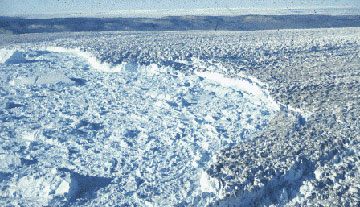Melting Antarctic glaciers could trigger sea level rise
Melting Antarctic glaciers could trigger sea level rise
mongabay.com
March 15, 2007

Perspective view of the Helheim Glacier at different times over the past 3 years. Between 2004 and 2005, the glacier front had retreated 3 miles inland and its ice discharge was accelerating. However, since then it has advanced to a new stable position. This erratic behaviour is a common feature of such tidewater glaciers, and complicates estimates of the ice sheet’s sea level contribution. (Image: Ian Howat)
Scientists have identified four melting Antarctic glaciers that could trigger a rapid rise in global sea levels according to a study published in the journal Science.
Using satellite observations, scientists from University of Edinburgh and University College London found that melting of ice sheets in Antarctica and Greenland at a rate of 125 gigatons of ice per year were responsible for about 12 percent, or 0.35 millimeters per year, of the observed rise in sea levels. Their research shows that while the Greenland ice sheet “is changing too erratically to establish a trend with confidence”, four major glaciers in East and West Antarctica are retreating in unison, increasing the risk of rapid change in sea levels.
“Our assessment confirms that just one type of glacier in Antarctica is retreating today — those that are seated in deep submarine basins and flow directly into the oceans,” said Dr. Andrew Shepherd, lead author and a professor at the University of Edinburgh’s School of GeoSciences. “These glaciers are vulnerable to small changes in ocean temperature, such as those that have occurred over the 20th century, and those predicted for the 21st century. A rise of less than 0.5 ºC could have triggered the present imbalance.”
|
Calving front of the Jakobshavn Isbrae, an outlet glacier of eastern Greenland, in 1985. Satellite studies since the 1990s have reported a progressive retreat of the ice front in tandem with accelerated ice discharge. However, this photo, which predates the satellite record, provides evidence that the glacier front has stood at a variety of positions in the past. (Image: David Sugden). |
While the authors note the importance of satellite monitoring of ice sheets, they say more specific study of certain ice streams and glaciers is needed to better predict future loss of ice-sheets in Antarctica and Greenland.
CITATION: A. Shepherd, A. and Wingham, D. (2007) “Recent Sea-Level Contributions of the Antarctic and Greenland Ice Sheets.”
This article is based on a news release from the University of Edinburgh.








